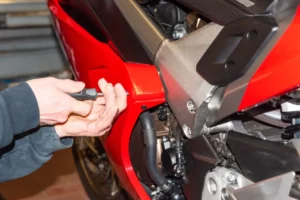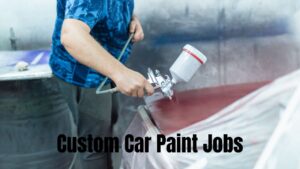Painting your car can seem scary, but with the right tools and techniques, you can get a pro finish. This guide will show you how to paint a car, from start to finish. You’ll learn how to make your car look new or totally change its look.

Key Takeaways
- Discover the essential steps to prepare your car’s surface for a flawless paint job
- Understand the differences between lacquer, enamel, and urethane paints to choose the best option for your car
- Master the spray painting technique and achieve an even, smooth coat
- Learn color matching and blending strategies for seamless transitions
- Explore the drying and curing process to ensure a long-lasting, professional-grade finish
Introduction to Painting Your Car
Painting your car can make it look new and fresh. It’s a great way to update your vehicle’s look. Whether you’re fixing up an old car or just want a new look, a fresh paint job can make a big difference. We’ll look at why you might want to paint your car and the benefits of a new coat.
Why Paint Your Car
There are many reasons to paint your car. Maybe your car’s paint is old, chipped, or faded. Or perhaps you’ve got a used car that needs a new look. DIY car painting is a cheaper way to make your car look new again, compared to professional car restoration.
Benefits of a Fresh Coat of Paint
- Increased resale value: A freshly painted car can make it more valuable to sell.
- Improved appearance: A new paint job can make your car look sleek and polished.
- Better protection: Fresh paint protects your car from UV rays, rain, and road debris, helping it last longer.
- Personalization: Painting your car lets you choose the color and finish you like, making it truly yours.
Understanding why and how painting your car can be beneficial is key. Next, we’ll explore how to prepare your car’s surface for painting.
Preparing the Surface for Painting
Getting a perfect car paint job begins with surface prep. Before painting, make sure your car’s surface is ready. We’ll show you how to prepare your car’s surface for the best results.
Sanding and Cleaning
The first step is to sand the existing paint. This removes imperfections and makes the surface smooth. Use coarse grit sandpaper first, then finer grit for a clean finish. After sanding, clean the area well with a degreaser to remove dirt and oils.
Addressing Underlying Issues
Before painting, fix any car body problems. This includes dents, rust, and structural issues. Fixing these problems ensures the new paint lasts longer and looks better.
| Car Paint Preparation Steps | Description |
|---|---|
| Sanding | Use coarse to fine grit sandpaper to remove the existing paint and create a smooth surface. |
| Cleaning | Thoroughly clean the surface with a degreasing agent to remove any dirt, oil, or contaminants. |
| Addressing Underlying Issues | Repair any dents, rust spots, or other structural problems to ensure a long-lasting paint job. |
Remember, proper car paint preparation is key for a lasting auto body repair. By following these steps, your car’s surface will be ready for new paint and look professional.
Understanding Different Paint Types
Not all paints are the same when it comes to cars. The paint you pick can change how your car looks and lasts. We’ll look at lacquer, enamel, and urethane paints to help you choose the right one for your car.
Lacquer vs. Enamel vs. Urethane
Lacquer paint is known for its shiny finish and quick dry time. It’s solvent-based and cheaper, but not as long-lasting as others.
Enamel paint gives a matte or satin look and protects against scratches and fading. It’s also good against heat, making it great for fast cars.
Urethane paint is the most advanced and lasts the longest. It’s glossy, resistant to scratches, and protects well against the environment. Though pricier, it offers a top-notch finish.
Choosing the Right Paint for Your Car
Think about what finish you want, how you’ll use your car, and your budget when picking paint. Lacquer is good for a shiny look. Enamel or urethane are better for durability. The best paint for you depends on your needs and what you like.
| Paint Type | Finish | Durability | Cost |
|---|---|---|---|
| Lacquer | High-gloss | Moderate | $ |
| Enamel | Matte/Satin | Good | $$ |
| Urethane | High-gloss | Excellent | $$$ |
Essential Tools and Supplies
Painting your car at home can be a fun DIY project. But, you need the right tools and supplies for a professional look. Whether you’re repainting the whole car or just fixing a few scratches, having the right equipment is key. We’ll show you the essential items for mastering spray painting techniques and auto body repair.
Essential Tools for DIY Car Painting
- High-quality spray gun designed for automotive painting
- Adjustable air compressor to power the spray gun
- Sanding tools, including a random orbital sander and various grit sandpaper
- Masking tape, drop cloths, and other protective gear to prevent overspray
- Paint mixing cups and stirring sticks
- Nitrile gloves and a well-ventilated paint booth or spray area
Choosing the Right Paint and Supplies
Choosing the right paint is crucial for DIY car painting. Think about the durability and finish you want, your skill level, and your budget. Lacquer, enamel, and urethane paints each have unique properties and application techniques. Make sure to research and choose the best paint and supplies for your project.
Proper preparation is essential for a flawless finish. Clean, sand, and prepare the surface well before painting. With the right tools and practice, you can give your vehicle a fresh, professional-quality paint job.
Mastering the Spray Painting Technique
Painting a car with spray paint is the most common and effective way. It’s key to get a professional finish. We’ll cover how to use a spray gun right and apply paint evenly.
Proper Spray Gun Usage
Using a spray gun well means adjusting a few things. First, set the air pressure and paint flow right for your job. This helps paint go on evenly. Hold the gun the right distance and move it smoothly while painting.
- Adjust the air pressure and paint flow for optimal performance
- Hold the spray gun at the right distance from the surface
- Use a steady, consistent motion when applying the paint
Achieving an Even Coat
Getting paint on evenly is key for a great look. Make sure to overlap each spray gun pass by 50% for full coverage. Also, focus on tricky spots and edges, painting them evenly.
- Overlap each pass of the spray gun by about 50%
- Carefully apply paint to hard-to-reach areas and edges
- Maintain a consistent distance and motion for an even finish
Remember, spray painting techniques are vital for car painting. Mastering the spray gun and even coat will get you a beautiful, new car look.
Color Matching and Blending
Getting a perfect color match and smooth blending is key for a top-notch automotive painting or vehicle refinishing job. We’ll look at the methods and tools to get a flawless color matching and a uniform finish.
Mastering the Art of Color Matching
Understanding the paint on your car is the first step to a great color match. Look at the color under different lights, noting any small changes or undertones. This info is vital for picking the right paint.
Use a paint color matching tool or app for an exact match. These tools analyze the paint and give a precise color code. Also, talk to a local automotive painting expert for advice and a custom color mix.
Blending New Paint for a Seamless Finish
With the right color, blend the new paint with the old areas carefully. Start by sanding the edges lightly for a smooth transition. Apply the new paint in thin layers, building up coverage and blending edges for a seamless look.
Try “feathering” for better blending. Spray paint in a fanning motion, easing off pressure and coverage at the edges. With patience, you’ll get a flawless vehicle refinishing finish.

| Technique | Description |
|---|---|
| Color Matching | Analyzing the existing paint color and precisely matching it to ensure a seamless blend. |
| Feathering | Gradually reducing paint coverage and pressure at the edges to create a smooth, blended transition. |
| Sanding | Lightly sanding the edges of the painted area to create a smooth surface for blending. |
Mastering these techniques will give you a color matching and blending that looks like the original paint. Your vehicle will have a flawless, professional automotive painting finish.
Drying and Curing the Paint
Proper automotive painting and car paint application don’t stop after painting. Drying and curing the paint are key to lasting beauty. We’ll show you the best drying and curing times for different paints. Plus, tips for a glossy finish that lasts.
The drying time varies by paint type. Lacquer-based paints dry quickly, in 30 minutes to an hour. Enamel paints take 2-4 hours. Urethane paints need up to 8 hours.
After drying, curing starts. This process hardens the paint for a durable finish. Curing times range from days to weeks, based on paint and environment. Always follow the manufacturer’s curing times for the best results.
- Lacquer paints: 1-2 weeks to fully cure
- Enamel paints: 1-4 weeks to fully cure
- Urethane paints: 2-4 weeks to fully cure
While curing, avoid washing, waxing, or harsh conditions. This lets the paint harden and shine. After curing, your car’s paint will be ready for the elements and look great for years.
How to Paint a Car
Painting your car yourself can be a fun DIY project. It can save you money and make you feel proud of your work. Whether you want to restore an old car or refresh your current one, painting it yourself is a great option. With the right steps and care, you can get a professional-looking finish.
Let’s look at the steps to paint a car:
- Prepare the Surface: Clean and sand the car’s surface well. This removes old paint, rust, or blemishes. It helps the new paint stick and look smooth.
- Apply the Primer: Choose a good primer that matches your paint. Apply it in thin, even layers. Let it dry fully before adding more.
- Spray the Paint: Get a quality paint sprayer and practice on a test area first. Spray the paint in thin, overlapping layers for even coverage.
- Finish with a Clear Coat: After the paint dries, add a clear coat. It protects the paint and gives a glossy finish.
Remember, painting a car takes patience and detail. Take your time and follow the steps carefully. You’ll end up with a beautiful, lasting paint job that you can be proud of.
“Painting your car can be a rewarding DIY project, but it requires patience and attention to detail to achieve a professional-looking result.”
Troubleshooting Common Painting Problems
Even with careful preparation and application, automotive painting can still face unexpected problems. In this section, we’ll tackle common issues like runs, sags, and orange peel. We’ll also share practical solutions to get your car looking flawless. Knowing these challenges can help you avoid them and fix them quickly if they happen.
Preventing and Fixing Run, Sags, and Orange Peel
Dealing with runs, sags, and orange peel can be frustrating in DIY car painting. These problems can spoil the look of your newly painted car. Here’s how to prevent and fix them:
- Runs and Sags: These happen when paint is applied too thickly or unevenly. To prevent, use the right spray gun technique, keep a steady distance, and apply paint in thin, even layers.
- Orange Peel: This bumpy finish is caused by paint drying too fast or wrong application. To slow drying, adjust your spray gun’s settings. Use a paint reducer to get the right consistency.
If you face runs, sags, or orange peel, stay calm. With patience and the right steps, you can sand down the problem areas. Then, reapply paint for a smooth, professional finish.

“The key to a flawless car paint application is understanding the common pitfalls and having the right strategies to overcome them.”
By using these tips and techniques, you’ll improve your automotive painting skills. You’ll be on your way to a perfect paint job for your car.
Finishing Touches and Clear Coat
After painting your car, the last step is applying the clear coat. It protects the paint and adds a glossy shine. We’ll show you how to apply the clear coat perfectly for a flawless finish.
Applying the Perfect Clear Coat
The clear coat is the last layer of paint. It seals and protects your car’s finish. Here are the essential steps to get the best results:
- Prepare the surface: Clean and decontaminate the painted area. Make sure it’s free of dust, debris, or imperfections.
- Choose the right clear coat: Pick a high-quality, durable clear coat that matches your paint. Talk to a professional or do your research.
- Apply the clear coat: Use a good spray gun and follow the instructions. Apply thin, even coats, letting them dry between each layer.
- Ensure even coverage: Focus on edges, corners, and hard spots. This ensures the clear coat covers the whole surface evenly.
- Allow for proper drying and curing: Follow the recommended times for drying and curing. This lets the clear coat harden and protect your paint.
By following these steps, you’ll get a glossy finish that makes your car stand out.
| Step | Description |
|---|---|
| Prepare the Surface | Clean and decontaminate the painted area to ensure a smooth, flawless finish. |
| Choose the Right Clear Coat | Select a high-quality, durable clear coat that is compatible with the type of paint used. |
| Apply the Clear Coat | Use a high-quality spray gun and follow the manufacturer’s instructions for proper application technique. |
| Ensure Even Coverage | Pay close attention to edges, corners, and hard-to-reach areas to achieve an even, consistent clear coat. |
| Allow for Proper Drying and Curing | Follow the recommended drying and curing times to ensure maximum protection for your car’s paint job. |
Mastering the clear coat application can elevate your car’s finish. With these tips, you’ll get a professional-quality finish that turns heads.
Maintaining Your Newly Painted Car
Congratulations on your successful DIY automotive painting project! To keep your car’s new paint looking its best, it’s important to properly maintain it. You’ll learn essential tips and tricks for caring for your freshly painted vehicle. This includes recommended cleaning products, proper washing techniques, and protection from the elements.
Proper maintenance is key to preserving the vibrant finish and prolonging the life of your car restoration work. By following these simple steps, you can ensure your DIY car painting efforts remain a source of pride for years to come.
Cleaning and Washing
Regular cleaning is crucial for maintaining your car’s new paint job. Use a high-quality car wash soap and avoid harsh chemicals or abrasive materials that could damage the finish. Gently wash your car using a soft microfiber cloth or sponge, working in small sections to ensure even coverage.
- Rinse your car thoroughly to remove all soap residue.
- Dry the surface with a clean, soft microfiber towel to prevent water spots.
- Consider using a paint sealant or ceramic coating to protect the paint from environmental factors.
Preventing Damage
To keep your car’s paint in pristine condition, it’s important to protect it from the elements. Park in a shaded area or use a car cover when possible to shield the paint from direct sunlight, bird droppings, and other environmental hazards.
- Regularly inspect your car for any scratches, chips, or other damage and address them promptly to prevent further deterioration.
- Avoid parking under trees or near construction sites, as debris and fallout can harm the paint.
- If you must park outdoors, consider applying a high-quality wax or sealant to provide an extra layer of protection.
By following these guidelines, you can maintain the vibrant, showroom-quality appearance of your newly painted car. Enjoy the fruits of your DIY car painting labor for years to come.
| Maintenance Task | Frequency |
|---|---|
| Wash car | Every 1-2 weeks |
| Apply paint sealant or ceramic coating | Every 6 months |
| Inspect for damage | Monthly |
| Wax or polish | Every 3-6 months |
Conclusion
Now you know how to paint a car like a pro. This guide has given you the skills to do it yourself. Whether you want to fix up an old car or make your current one look new, you can do it.
First, you need to get the surface ready and pick the right painting supplies. Then, learn how to spray paint and match colors perfectly. You’re all set to change your car’s look.
Start this DIY project with excitement. You’ll be proud of the amazing job you do. Happy painting!
With your new skills, you can make your car look amazing. Get ready to impress everyone with your handiwork.
FAQ
What are the key benefits of painting your car?
Painting your car can increase its resale value and make it look better. It also protects against the elements. A fresh paint job can make an old car look new and stand out.
How do I properly prepare the surface for painting?
To get a great paint job, start with proper surface prep. Sand, clean, and degrease the surface to remove old paint and rust. Fix any dents or scratches for a flawless finish.
What are the different types of automotive paint, and which one is best for my project?
There are three main types of paint: lacquer, enamel, and urethane. Lacquer dries fast and has a high-gloss finish. Enamel is durable and long-lasting. Urethane offers great protection and a modern look. Choose the best paint for your project based on your needs and preferences.
What essential tools and supplies do I need to paint my car?
You’ll need a good spray gun, a paint booth or a well-ventilated area, sanding tools, and protective gear. Pick the right tools for your skills and budget to get professional results.
How do I properly use a spray gun and apply an even coat of paint?
Mastering spray painting is key for a perfect finish. Adjust the gun’s air pressure and paint flow. Use the right spraying techniques for an even coat. Always follow safety precautions when using spray paint.
How do I ensure a perfect color match and seamless blending?
For a professional look, match colors perfectly and blend them well. Use the right tools and techniques for color matching and blending. This ensures a smooth, uniform finish.
How do I properly dry and cure the paint to ensure a long-lasting finish?
Drying and curing paint properly is crucial for a lasting finish. Follow the recommended times and processes for your paint type. Use the right techniques for a hard, glossy finish that lasts.
What are some common painting problems I might encounter, and how do I fix them?
Even with careful prep and techniques, problems can still happen. Issues like runs, sags, and orange peel can occur. Learn how to identify and fix these problems for a flawless finish.
How do I properly apply the clear coat to protect my car’s new paint job?
Applying the clear coat is the final step. It protects the paint and gives a glossy finish. Learn the best methods for applying the clear coat, including drying times and finishing touches, to keep your car’s paint looking professional for years.
How do I maintain my newly painted car to keep it looking its best?
To keep your car’s paint looking great, maintain it properly. Use the right cleaning products and follow washing techniques. Protect your car from the elements. These tips will help your car look showroom-ready for years.






